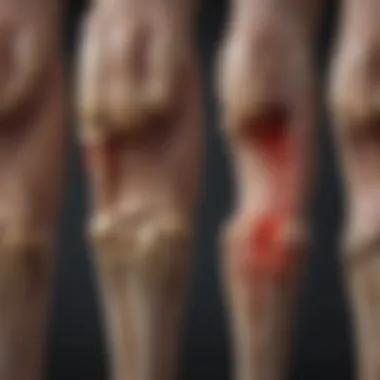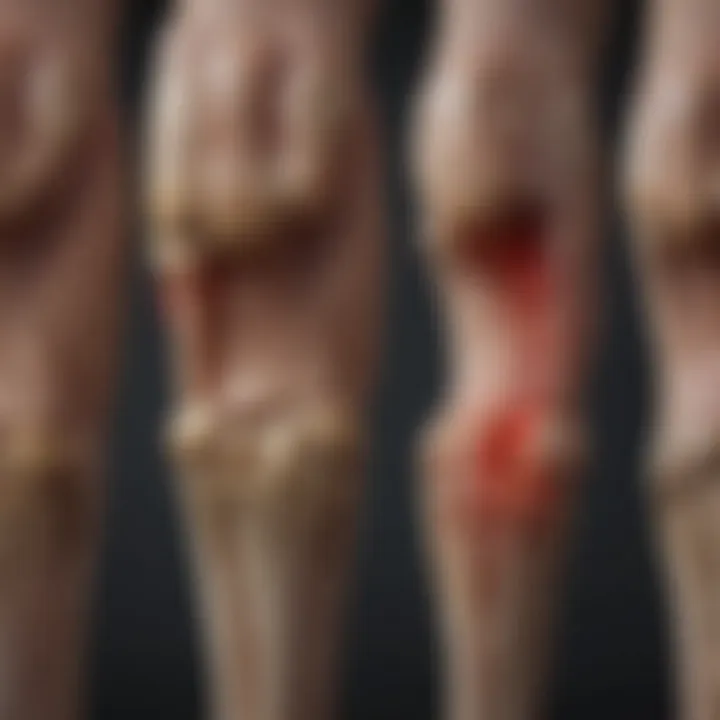Understanding Osteoarthritis Prognosis: A Comprehensive Guide


Intro
Osteoarthritis (OA) stands as a leading cause of chronic pain and physical disability worldwide. As individuals age, the wear and tear on their joints can accumulate, leading to a plethora of symptoms that vary greatly from one person to another. Grasping the nuances of OA prognosis is essential for healthcare providers, patients, and caregivers alike. With many factors influencing how the disease manifests and progresses, understanding the landscape of osteoarthritis-related outcomes can empower both medical professionals and patients.
The prognosis of osteoarthritis isn't a one-size-fits-all equation. Several elements come into play, including age, genetics, lifestyle choices, body weight, and concurrent health issues. Each of these variables can shift the trajectory of the disease, leading to different experiences even among patients with seemingly similar conditions. Therefore, an in-depth examination of osteoarthritis prognosis is both timely and critical, as it encourages a more personalized approach to management and care.
In the sections following, we explore the key concepts, evidence-based findings, and potential research avenues related to osteoarthritis prognosis. By doing so, we aim to enhance the understanding of this multifaceted condition and its implications.
Intro to Osteoarthritis
Osteoarthritis, a degenerative joint disease, stands as one of the prevailing musculoskeletal disorders facing individuals across the globe. The significance of delving into osteoarthritis in this article arises from its widespread impact on both patients and the healthcare system. With its increasing prevalence in aging populations and those with prior joint injuries, understanding the underlying mechanisms, risk factors, and treatment options is crucial. As we explore the nuances of prognosis in osteoarthritis, laying the groundwork with a fundamental grasp of the condition itself is paramount.
Definition and Overview
At its core, osteoarthritis essentially involves the breakdown of cartilage—the cushioning material between bones within joints. Over time, this degradation leads to symptoms like pain, stiffness, and swelling. Everyday activities may become laborious, diminishing one's overall quality of life. For instance, someone once able to jog effortlessly might find themselves hobbled, grappling with the simplest movements due to this ailment.
From a technical perspective, osteoarthritis is often classified as a chronic condition with a gradual onset. Unlike other inflammatory arthritis types, it builds slowly, deceptively luring individuals into a false sense of normalcy until its debilitating effects manifest. A holistic understanding encompasses not just the biological but also the emotional and psychosocial dimensions impacting patients’ lives.
Epidemiology of Osteoarthritis
Statistics spotlight the staggering reach of osteoarthritis: it is estimated that over 300 million individuals suffer globally. The incidence increases with age, with significant variations noted across genders, often affecting women more than men, especially post-menopause. It doesn't merely cluster among the elderly; younger individuals with joint injuries or those carrying excess body weight also find themselves at risk.
Factors influencing demographics include geographical location and lifestyle choices. For example, researchers have observed differences in prevalence rates between urban populations with sedentary habits and those in rural settings where physical activity is more prominent. This information can inform effective public health strategies and individual preventive measures.
"Understanding the prevalence and characteristics of osteoarthritis cases empowers healthcare providers to tailor interventions that better suit different population segments."
Through these insights into osteoarthritis, we brace ourselves for a deeper exploration of prognosis in the subsequent sections. With a wide array of elements contributing to disease progression, a comprehensive understanding empowers both patients and healthcare practitioners alike.
Understanding Prognosis
Understanding prognosis in osteoarthritis is much more than just predicting the future of this chronic condition; it’s about grasping the intricate dynamics that influence a person's quality of life. Prognosis serves as a crucial compass for both patients and healthcare providers, steering the journey of treatment decisions and lifestyle adaptations. With a proper understanding of prognosis, patients can make more informed choices, while clinicians can tailor their interventions and therapies effectively. This ensures that both parties are on the same page, aiming toward a common goal of improving health outcomes.
Several elements contribute to the overall prognostic picture of osteoarthritis. Age, genetics, weight, and previous joint injuries are some major factors at play. Each of these elements weaves together, creating a unique tapestry that affects how swiftly or slowly the condition progresses for an individual. Furthermore, understanding prognosis arms patients with the knowledge to engage in proactive management of their health, rather than merely reacting to symptoms as they arise.
Among the benefits of understanding prognosis is the ability to anticipate changes in the condition and the potential impact on daily life. This can alter the course of treatment plans more dynamically than one might expect. Knowing what to expect helps patients psychologically prepare for future challenges and allows them to prioritize their physical activities accordingly. It’s akin to steering a ship in a storm; with the right tools and information, the journey can be navigated more skillfully.
Another consideration about understanding prognosis is recognizing its limitations. While predictions can be made based on existing knowledge and data, every individual is different. This personal variability means that prognostic assessments can sometimes miss the mark, serving as a reminder that medical predictions aren't foolproof. Still, they provide a valuable framework for understanding potential outcomes and can serve as a guideline for personalized care.
"The clearer the picture is for a patient, the more empowered they feel in managing their own health."
In summary, understanding prognosis in osteoarthritis is a foundational element in orchestrating appropriate care for individuals. It equips both the patient and their healthcare team with essential insights to navigate the ups and downs throughout the course of the disease.
Factors Influencing Prognosis
In understanding the prognosis of osteoarthritis, it is crucial to examine various factors that contribute to the progression of this chronic joint condition. Each element influencing prognosis can shape a patient's treatment plan, alongside their long-term health outcomes. Highlighting these aspects not only provides clarity on disease progression but also aids in tailoring management strategies to individual needs. Here, we explore key factors like age, gender, weight, genetic backgrounds, and previous joint injuries that play a significant role in the overall prognosis of osteoarthritis.
Age and Gender Differences
Age significantly impacts the prognosis of osteoarthritis. Generally, as one ages, the likelihood of developing osteoarthritis rises, largely due to cumulative wear and tear on joints. Older adults often present with more severe symptoms, affecting their mobility and quality of life. Additionally, gender plays a crucial role; for instance, women are more prone to osteoarthritis post-menopause due to hormonal changes that affect joint health. This differentiates the age-related patterns between men and women, often leading to diverse clinical outcomes.
This difference in incidence and severity suggests that age and gender not only influence diagnosis but also the approaches taken in treatment. Understanding these distinctions is crucial for clinicians to devise effective management strategies tailored to specific sub-groups.
Weight and Body Mass Index
Excess weight operates as a significant risk factor for osteoarthritis, especially concerning weight-bearing joints like the knees and hips. Higher Body Mass Index (BMI) has been directly linked to increased stress on joints, which can accelerate the wear and tear process. The relationship between body weight and joint health cannot be overstated; adjustments in body weight can lead to substantial changes in joint pain and function.
In practical terms, this means that interventions focusing on weight loss may greatly enhance the prognosis for those experiencing osteoarthritis. By addressing weight management alongside other therapeutic options, healthcare providers can improve patient outcomes effectively.


Genetic Predisposition
Genetics is another important piece of the puzzle in osteoarthritis prognosis. Certain genetic markers can indicate a predisposition to the condition, impacting how individuals respond to various risks. If osteoarthritis runs in families, it often serves as a red flag for potential joint issues.
Researchers continue to study the relationship between these genetic components and the disease's progression. Understanding genetic predispositions can help predict the severity and outcome of osteoarthritis, guiding preventive measures and customized treatment approaches for those at higher risk.
Previous Joint Injuries
History of joint injuries is a significant prognostic factor as well. Many people who have experienced prior injuries to their joints, whether through sports, accidents, or other means, are at elevated risk for developing osteoarthritis later in life. This prior trauma may predispose joints to early degeneration, leading to accelerated onset of symptoms.
Documenting a patient’s history of joint injuries is vital for healthcare practitioners. Such insights can shape clinical decisions regarding prognosis, allowing for proactive measures in monitoring and managing joint health.
Overall, acknowledging these influencing factors provides a framework for understanding the complex landscape of osteoarthritis prognosis. By integrating a comprehensive awareness of age, weight, genetic predispositions, and previous injuries, healthcare professionals can devise more effective treatment plans and ultimately improve patient care.
Clinical Features and their Relevance
Understanding the clinical features of osteoarthritis (OA) is paramount to grasping how the disease affects individuals. These features not only help in forming a diagnosis but also play a crucial role in determining the prognosis and guiding management decisions. Recognizing symptoms and correlating them with findings from diagnostic tests can significantly tailor the approach towards treatment. This specificity not only enhances the quality of life for patients but also aids healthcare providers in developing effective management strategies.
Common Symptoms of Osteoarthritis
Osteoarthritis manifests through a constellation of symptoms that can vary widely between individuals. Some common symptoms include:
- Joint Pain: This is often the hallmark of osteoarthritis. Patients may experience pain after activity that tends to lessen with rest. Over time, this pain might become more frequent, affecting the ability to perform daily tasks.
- Stiffness: Many people with OA report morning stiffness, lasting usually less than 30 minutes. This stiffness can significantly impede mobility, making activities of daily living a chore.
- Swelling: The affected joint may show swelling due to inflammation and excess fluid. This can indicate that the joint is under stress or damage.
- Decreased Range of Motion: Individuals might notice difficulty in moving their joints fully. For instance, bending or straightening the knee might cause discomfort, showcasing the impact of joint degeneration.
- Crepitus: Patients frequently describe a grating sensation or sound when moving the afflicted joint, which indicates irregularities in cartilage and joint surfaces.
These symptoms serve not just as indicators of disease presence but are also pivotal in assessing severity and progression. Understanding these features can foster better patient-practitioner conversations, leading to more proactive management.
Radiological Findings
The role of radiological findings cannot be overstated when it comes to diagnosing and assessing osteoarthritis. Imaging techniques—predominantly X-rays and MRIs—play a critical role in evaluating the progression of the disease.
"Imaging techniques can reveal the underlying changes that may not be apparent through physical examination alone."
Key radiological findings indicative of OA include:
- Joint Space Narrowing: This signifies the loss of cartilage between the bones. As cartilage deteriorates, the space between the joint surfaces diminishes, which can lead to increased friction and pain.
- Osteophyte Formation: These are bone spurs that develop at the edges of joints, often visible in X-rays. Their presence is a clear indicator of osteoarthritis and reflects the body's response to joint degeneration.
- Subchondral Sclerosis: This term refers to increased density of the bone just below the cartilage. It can be a response to stress overload, commonly seen in weight-bearing joints like the knees.
- Cysts: Fluid-filled sacs can develop in the bone next to the arthritic joint, which can also be identified via imaging.
These findings are invaluable for a comprehensive prognosis and help in determining the best course of action for management. Assessing the presence and extent of these features allows for more accurate predictions regarding disease course and potential interventions.
Diagnostic Approaches
Establishing an accurate diagnosis for osteoarthritis is not just a formality; it serves as the cornerstone for effective management and treatment options. The diagnostic phase is critical, as it informs healthcare professionals about the nature and severity of the condition, enabling them to tailor interventions that could significantly enhance a patient's quality of life. Missteps at this stage can lead to inappropriate management plans and ultimately worsen the patient's condition. Thus, a deep dive into diagnostic approaches unearths the fundamental processes that guide clinicians in understanding osteoarthritis more effectively.
Initial Assessment and Screening
The first step in diagnosing osteoarthritis typically involves a comprehensive initial assessment. This is more than just a cursory glance at the patient's symptoms. It includes gathering a detailed patient history along with a thorough physical examination.
- Patient History: This entails probing into the patient’s experience with joint pain, stiffness, and any immobilization. A history of previous injuries or surgeries is also crucial. Notably, specific chronic illnesses can predispose individuals to osteoarthritis, so discussing family background may provide valuable insights.
- Physical Examination: Upon physical examination, doctors look for signs such as swelling, tenderness, crepitus, and decreased range of motion in joints. This hands-on investigation brings to light issues that might not be overtly expressed by patients.
- Screening Tools: Certain standardized tools like the Western Ontario and McMaster Universities Osteoarthritis Index (WOMAC) can help gauge the severity of pain and functional impairment. These tools give a quantifiable aspect to subjective complaints, allowing the clinician to rate the impact of osteoarthritis on daily life.
It's noteworthy that in the early stages, osteoarthritis can often be mistaken for other joint conditions. Therefore, specificity in this initial phase is indispensable.
Role of Imaging Techniques
While initial assessments set the groundwork, imaging techniques fill in the gaps by providing a concrete view of what’s happening inside the joint. Imaging serves as an integral complement to the subjective data derived from the patient and physical examination.
- X-rays: Often the first line of imaging, they can pinpoint changes such as joint space narrowing, bone spurs, and cartilage loss, all of which signal osteoarthritis. However, an X-ray might miss early degenerative changes since its effectiveness is tied largely to the severity of the disease—hence, it may not illustrate soft tissue issues.
- MRI Scans: These provide a detailed, three-dimensional view of joint structures, capturing crucial soft tissue damage that X-rays cannot. MRIs can show cartilage thickness, synovial fluid volume, and even bone marrow lesions. Its usage is, however, less common in everyday clinical practice due to costs and the need for specialized facilities.
- Ultrasound: This technique is emerging as a flexible tool for a bedside diagnosis. It evaluates synovial fluid, detect joint effusions and visualize soft tissues surrounding the joint—important features that X-rays miss. Its real-time imaging capabilities also afford clinicians the ability to conduct dynamic assessments.
In summation, the diagnostic approaches employed in osteoarthritis revolve around a multi-faceted strategy that bridges subjective assessments with objective imaging outcomes. Utilizing a combination of initial screenings and advanced imaging techniques not only aids in accurate diagnosis but also lays the groundwork for constructing a holistic, patient-centric management plan.
"A precise diagnosis is pivotal; it serves as the launching pad from which a tailored treatment strategy can be devised."


Prognostic Tools and Scoring Systems
In the realm of osteoarthritis, the significance of prognostic tools and scoring systems cannot be overstated. They serve as beacons, guiding clinicians and researchers alike as they navigate the muddy waters of disease progression and individual patient outcomes. By leveraging these tools, healthcare providers can make informed decisions, tailoring treatment plans that resonate with each patient's unique presentation. This section delves into the various prognostic models and emphasizes their practical implications, as well as the salient limitations that accompany these assessments.
Commonly Used Prognostic Models
Several widely recognized prognostic models exist in the landscape of osteoarthritis that aid in assessing disease severity and potential outcomes. Among these tools, the Western Ontario and McMaster Universities Osteoarthritis Index (WOMAC) stands out for its thorough evaluation of pain, stiffness, and functional limitations. This index helps pinpoint the areas of most concern for patients, making it easier to understand how the disease is affecting their day-to-day life.
Another model gaining traction is the Osteoarthritis Research Society International (OARSI) recommendations. These guidelines provide a detailed framework for evaluating clinical features and radiological signs. They can be particularly beneficial in predicting long-term prognosis based on a combination of clinical findings and socio-demographic factors.
Furthermore, the Kellgren-Lawrence (KL) grading system remains a fundamental approach for classifying the radiographic severity of osteoarthritis. By assessing joint space narrowing and the presence of osteophytes, this tool provides a visual aid in evaluating the progression of the disease over time.
"Effective prediction of osteoarthritis progression hinges not merely on clinical observations but on structured tools that synthesize diverse patient data."
These models facilitate communication between patients and healthcare professionals, bridging gaps in understanding and expectations. This ultimately fosters a more collaborative approach to managing osteoarthritis, thereby enhancing patient-centered care.
Limitations of Current Tools
Despite the benefits associated with prognostic tools, it's essential to acknowledge their inherent limitations. One significant challenge is that many of these models heavily rely on subjective patient reports, which can lead to inconsistencies. For instance, pain perception varies immensely from person to person, and this variability can skew results.
Additionally, the tools often do not take into account the full spectrum of factors influencing osteoarthritis prognosis. While they might emphasize clinical symptoms, social determinants such as socioeconomic status, mental health, and overall lifestyle choices can play pivotal roles but often get sidelined.
Moreover, while clinical guidelines like the ones from OARSI provide a structured pathway for assessing osteoarthritis, they are not universally adopted, leading to discrepancies in practice. This lack of standardization can confuse both practitioners and patients.
In summary, while prognostic tools and scoring systems are invaluable assets in understanding osteoarthritis prognosis, they are not without flaws. Recognizing their limitations enables better use and encourages ongoing research to refine these tools for future applications. Understanding these aspects can help steer the development of more robust, inclusive prognostic frameworks tailored to a diverse patient population.
Management Strategies and Their Impact
Management strategies are crucial in the realm of osteoarthritis prognosis. The effectiveness of a treatment plan not only influences the individual’s symptom relief but also impacts the overall trajectory of the disease. It is essential to address the various facets of management—non-pharmacological, pharmacological, and surgical interventions—since each plays a distinct role in ensuring that individuals can lead their lives with minimal discomfort and maximum functionality.
Effective management strategies can lead to better outcomes for patients, adapting to their unique situations and needs. Moreover, these strategies can serve as a compass for practitioners navigating the complexities of osteoarthritis.
Non-Pharmacological Interventions
Non-pharmacological interventions are often the first line of defense when managing osteoarthritis. For many patients, lifestyle adjustments and physical therapies yield substantial benefits without the potential side effects associated with medications.
- Physical Exercise: Engaging in regular low-impact exercises—like swimming or cycling—helps strengthen muscles around affected joints, improve flexibility, and reduce stiffness. Many professionals advocate for tailored exercise programs, ensuring they meet the specific needs of each patient.
- Weight Management: For patients carrying extra pounds, weight loss can significantly alleviate stress on weight-bearing joints. Losing even a modest amount of weight can lead to marked improvement in symptoms and functioning.
- Therapies: Techniques such as physical therapy or occupational therapy can teach patients how to manage their condition effectively. Therapists may use modalities like ultrasound or electrical stimulation in the treatment process.
- Education: Providing patients with thorough information about osteoarthritis instills confidence, allowing them to take charge of their health. Armed with knowledge, patients can better navigate their treatment options and understand their condition.
Pharmacological Treatments
When non-pharmacological strategies alone do not suffice, pharmacological treatments can step in to provide relief. The medications used in osteoarthritis management typically fall into several categories:
- Analgesics: Simple pain relievers like paracetamol can assist in managing pain, sometimes without the complications of stronger drugs.
- Non-steroidal Anti-Inflammatory Drugs (NSAIDs): Medications such as ibuprofen or naproxen are common choices that help reduce pain and inflammation. However, long-term use comes with risks that must be weighed against the benefits.
- Corticosteroids: In some cases, corticosteroids may be injected directly into an affected joint to provide quick relief. These can be effective but are not typically a long-term solution due to potential side effects.
- Disease-Modifying Osteoarthritis Drugs (DMOADs): These options are geared towards modifying the disease process itself, though their efficacy and safety are still under research. It’s important to discuss all options with healthcare providers to find tailored pharmacological solutions.
Surgical Options
For some individuals, especially those with advanced osteoarthritis, when conservative management fails, surgical options may be a consideration. Surgery can dramatically alter the course of the disease and improve quality of life.
- Arthroscopy: This minimally invasive procedure can clean out debris from the joint, leading to improved function and less pain.
- Osteotomy: For younger patients with localized arthritis, osteotomy involves cutting and reshaping bones to relieve pressure on the affected joint.
- Joint Replacement: In severe cases, surgical intervention may require complete joint replacement, such as knee or hip replacements. This option can provide substantial pain relief and restore function, allowing individuals to return to daily activities.
Managing osteoarthritis involves a multifaceted approach, where each strategy—be it lifestyle changes, medications, or surgery—plays a vital role. The ultimate aim is to provide relief, enhance functionality, and improve overall quality of life. It’s a cooperative dance between patient and practitioner, navigating pain towards a brighter horizon.
"A journey of a thousand miles begins with a single step."
Each step taken in managing osteoarthritis can make a difference, restoring hope and vitality to those affected.
Long-Term Prognosis and Outcomes


Long-term prognosis and outcomes in osteoarthritis are crucial elements that provide insights not only into the disease's trajectory but also into how it fundamentally affects the patient's quality of life over time. Understanding this topic is vital for clinicians and researchers alike as it helps in framing realistic expectations and tailoring effective management strategies for individuals affected by this chronic condition. This section delves into the nuances that shape long-term outcomes, emphasizing the variability in disease progression and the associated quality of life considerations.
Variability in Disease Progression
Osteoarthritis does not adopt a one-size-fits-all approach; rather, its progression can resemble a winding road full of unexpected twists and turns. Various factors play into this variability, including the patient's age, genetic background, joint usage, and overall lifestyle choices.
For some individuals, osteoarthritis progresses slowly, with only mild symptoms that can be managed effectively over many years. Others may experience a more rapid decline in joint function, often leading to significant disability and discomfort.
- Age and Joint Health: Generally, older adults tend to exhibit more pronounced symptoms, but even younger individuals can experience severe progression, especially if they have pre-existing joint issues from past injuries.
- Activity Levels: Engaging in physical activities can have a dual impact. While regular exercise strengthens the muscles around a joint, excessive strain can exacerbate wear and tear, leading to hastened progression.
- Comorbidities: The presence of other health conditions, such as obesity or diabetes, complicates the picture. For example, excess weight can lead to higher stress on weight-bearing joints, while diabetes may impede healing processes in the cartilage.
Understanding these variables allows healthcare professionals to devise personalized management plans aimed at slowing progression and improving joint health.
Quality of Life Considerations
The quality of life for individuals with osteoarthritis often fluctuates alongside the progression of their condition. It's not just about how much pain someone feels; it extends into how the disease affects their daily activities, mental well-being, and social interactions.
"Quality of life considerations are paramount in navigating the complexities of osteoarthritis management."
- Physical Functioning: As osteoarthritis advances, individuals may find themselves limited in their ability to partake in routine tasks. This decline can affect their independence, making everyday activities feel like monumental challenges.
- Psychological Impact: Chronic pain and reduced functionality also take a toll on mental health. Anxiety and depression are common among those dealing with severe arthritis, creating a vicious cycle that can further deteriorate quality of life.
- Social Implications: Individuals might find they withdraw from social engagements or family activities due to discomfort or embarrassment over their mobility challenges. This isolation can worsen mental health, underscoring the need for a holistic approach in management.
To enhance quality of life, multidisciplinary strategies involving physical therapy, psychological support, and nutritional guidance are critical components of care that patients should consider. Evaluating outcomes through this lens can lead to more meaningful conversations about what prognosis truly means for the individual.
Future Directions in Osteoarthritis Prognosis
Osteoarthritis is a complex condition that affects millions around the globe. As we venture into the topic of future directions in osteoarthritis prognosis, it’s essential to recognize that advancements in research and personalized medicine hold great promise for enhancing patient care. While many studies have outlined the typical disease trajectory, future developments will likely hinge on refining prognostic models. This progression will not only allow for better risk assessment but also pave the way for tailored interventions that recognize individual variances in disease manifestation and progression.
From understanding genetic predispositions to the role of lifestyle factors, there’s much at stake. Recent research suggests that understanding these nuances can lead to improved outcomes. As we delve deeper, the focus shifts towards predictive analytics and innovative treatment pathways that may redefine how we manage osteoarthritis in clinical settings.
Research Trends and Innovations
In the research landscape, novel trends and innovations are beginning to shape the realm of osteoarthritis prognosis. One such trend is the use of machine learning algorithms to analyze extensive datasets from patient demographics, clinical histories, and even genetic markers.
These methods can help identify patterns in disease progression that weren’t previously recognized. Biomarkers are being investigated for their potential to indicate disease severity and predict outcomes. This could allow healthcare professionals to intervene earlier, adapting strategies before significant deterioration occurs.
Moreover, interdisciplinary approaches involving bioinformatics and genomics are also gaining traction. By harnessing these tools, it’s possible to create more precise prognostic models. For example:
- Collaborations with tech companies focus on wearable health devices, providing real-time data on joint health.
- Clinical trials are experimenting with regenerative medicine techniques, like stem cell therapies, that might alter disease progression.
These innovations signal a shift towards an era where data-driven insights inform clinical practice, thereby enhancing the prognosis of osteoarthritis.
Personalized Medicine and Prognostic Indicators
As we shift gears towards personalized medicine, understanding prognostic indicators becomes vital. No two patients experience osteoarthritis in the same way, influenced by a smorgasbord of factors such as age, gender, lifestyle, and genetic background. This nuance calls for a personalized approach to treatment plans that accounts for individual risks and responses.
New stratified models are conceptualizing how to integrate various prognostic indicators into a cohesive framework that aids clinicians. The use of patient-reported outcomes and quality of life measures will likely play a central role in these assessments, providing insights into how symptomatic management can lead to better overall health.
"The future of osteoarthritis management lies not only in treating the symptoms but in understanding the unique journeys of each patient."
Through personalized treatment regimens, patients can expect a more nuanced and effective strategy that adapts to their unique situations. This approach may involve a cocktail of therapies, combining pharmacological treatments, physical therapy, and lifestyle modifications tailored to individual needs.
Epilogue
The conclusion of our exploration into osteoarthritis prognosis brings to light a multitude of crucial elements, crystallizing the core takeaways from the preceding sections. It serves not only as a summary but as a reflective contemplation on the intricate webs that knit together factors influencing the progression and management of osteoarthritis.
Summary of Key Findings
In reviewing the key findings, three pivotal points emerge clearly:
- Multifaceted Influences: The factors affecting osteoarthritis prognosis are diverse, ranging from age and gender to genetics and historical injuries. Each element plays a distinct role in shaping how the disease manifests and progresses in individuals.
- Prognostic Tools and Assessment: We have explored various prognostic models, each with its own strengths and limitations. Tools such as the WOMAC Index and other scoring systems provide insight, yet the variability in individual response highlights the need for ongoing refinement and development in these models.
- Integration of Management Strategies: Effective management plans that incorporate both non-pharmacological and pharmacological interventions can significantly enhance patient outcomes. Understanding how treatment approaches impact quality of life is vital to tailoring effective care strategies.
Implications for Future Research and Practice
Looking ahead, the implications for future research and practice cannot be overstated. As our understanding deepens, several avenues are worth pursuing:
- Personalized Medicine: There is a pressing need for research focusing on personalized treatment plans that consider the unique prognostic factors of each patient. Such an approach could lead to more effective interventions tailored to the individual's specific profile.
- Innovation in Prognostic Tools: Enhancing existing tools and creating new ones that utilize advanced data analytics may improve the accuracy of prognosis. This can empower healthcare providers to make more informed decisions.
- Further Investigations: As we continue to unearth the pathology of osteoarthritis, longitudinal studies and diverse patient populations can contribute immensely to understanding disease progression across various demographics.







